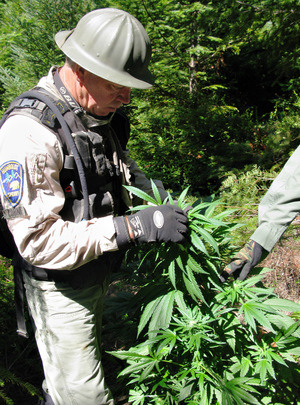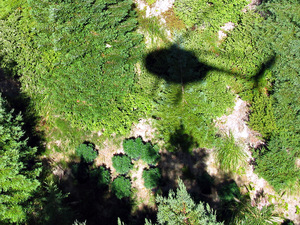Wednesday, December 02, 2009
California spends millions of dollars trying to wipe out a plant that's already sanctioned
alifornia Officials Target Big Marijuana Growers
December 1, 2009
Listen to the Story
All Things Considered
[7 min 38 sec]
Second of a two-part report

Enlarge Mandalit del Barco/NPRMembers of the Campaign Against Marijuana Planting (CAMP) task force, like Steve Cobine, will often hike into rugged terrain to destroy illegal marijuana grows. Illegal grows are often guarded by scarecrows, mannequins, rat traps and, at times, the crop's gardeners — though officers rarely catch anyone in the act.
Mandalit del Barco/NPR
Members of the Campaign Against Marijuana Planting (CAMP) task force, like Steve Cobine, will often hike into rugged terrain to destroy illegal marijuana grows. Illegal grows are often guarded by scarecrows, mannequins, rat traps and, at times, the crop's gardeners — though officers rarely catch anyone in the act.
Members of the Campaign Against Marijuana Planting (CAMP) task force, like Steve Cobine, will often hike into rugged terrain to destroy illegal marijuana grows. Illegal grows are often guarded by scarecrows, mannequins, rat traps and, at times, the crop's gardeners — though officers rarely catch anyone in the act.
These days, medical marijuana clinics are popping up like weeds in California. Los Angeles alone has nearly 1,000 places where, with a doctor's note, you can legally buy pot.
But the illegal side of marijuana is also thriving. Authorities say it's partly because all those pot clinics have boosted the demand. That means the state spends millions of dollars trying to wipe out a plant that's already sanctioned.
The Eyes Are Watching
For decades, a task force of lawmen has been parachuting into some of the most rugged sections of California. For a week at a time, they search for and destroy as much pot as they can find. They call it the Campaign Against Marijuana Planting, or CAMP.
On a recent day, NPR joined CAMP in a helicopter to hunt for cannabis in Humboldt County in Northern California.
It takes a trained eye to see the plants, because they're hidden in the trees. Circling over a dense stand of redwood trees, we spot some. Then we head for the landing zone.
Retired Humboldt County Sheriff's Lt. Steve Cobine says cultivating cannabis is now a big business in state forests and private timberlands.
"It has a distinctive color — emerald green," says Cobine. "You can't miss it."
We hike to one of the places we spotted from the air, clearing a path along the way with machetes. Every few feet, there's a marijuana plant. There are rat traps set, and poison to keep away any rodents from eating the plants. And there are long drip lines — irrigation lines that water these plants.
Cobine says pot growers will camp out at illegal sites like this for months to secretly cultivate and harvest marijuana. Sometimes they try to scare people away with mannequins, or scarecrows wearing clothing.
"It wakes you up," says Cobine. "You never think you're alone. At least I know I don't."
Eyes could be watching at all times, he says. The growers run off and hide in the brush — though they can't get far.
But Cobine says CAMP rarely catches anyone in the act. The growers are often armed, and have been known to shoot at anyone who comes near.
"We're always finding guns," he says. "We found three last week in a garden. One was a Beretta 9mm, one was a government .45 automatic pistol."

Enlarge Mandalit del Barco/NPRCAMP uses helicopters to spot marijuana grown illegally on public land. The plant's emerald green color stands out from the forest, though it can still be difficult to see.
Mandalit del Barco/NPR
CAMP uses helicopters to spot marijuana grown illegally on public land. The plant's emerald green color stands out from the forest, though it can still be difficult to see.
'All Races, Creeds, Colors'
Many of these illegal marijuana fields are the work of major drug cartels, says Jack Nelsen, a special agent with California's Bureau of Narcotic Enforcement.
"It's all races, creeds, colors," he says. "Everyone's growing. We've got it all going on."
Nelsen says Asian drug trafficking organizations grow marijuana in national forests, and Hispanic operations grow mostly on private lands. Others grow marijuana in illegal indoor greenhouses.
"We used to call them guerrilla grows, the white boy grows," Nelsen says. "Those are generally smaller, very high-quality large plants — not thousands of plants like the Hispanic drug operations."
According to Nelsen, the so-called Hispanic drug cartels have upward of 100,000 plants at any given grow.
"Hispanic grows sometimes look like cornfields," he says. "But the Asian drug trafficking organizations tend to plant on very, very steep areas."
Nelsen says the marijuana business exploded after California voters passed Proposition 215. The state now allows people to use medical marijuana with a doctor's recommendation, known as a 215 card.
"Everyone's got a medical recommendation in Humboldt County," he says, half joking. "It's the Humboldt County insurance policy. You can carry 3 pounds in your car with a recommendation. They think."
The local and state legalities are quite confusing, Nelsen says.
"Because of the loopholes and, especially in this county, how liberal the view is on how many plants you can have and how much marijuana you can have in your house, we've become an area many out-of-staters flock to. I call it the green rush."

Enlarge Mandalit del Barco/NPRSeized marijuana plants are hauled out of desolate areas and buried 10 feet below the ground in undisclosed locations. In 2009, CAMP found and destroyed more than 4 million plants from around California, but that is likely only a dent in the crop of illegally grown marijuana plants.
Mandalit del Barco/NPR
Seized marijuana plants are hauled out of desolate areas and buried 10 feet below the ground in undisclosed locations. In 2009, CAMP found and destroyed more than 4 million plants from around California, but that is likely only a dent in the crop of illegally grown marijuana plants.
Local police say they don't have time or resources to arrest every small-time marijuana grower in Humboldt. District Attorney Paul Gallegos says he'd rather go after the bigger growers.
"Our priority is business people," he says from his office in Eureka, Calif. "If you're growing for yourself, really, that's against the law. But why am I interested in that? I still have to enforce the laws, but you're low priority for me."
Humboldt County Sheriff Gary Philp says it's difficult to track down the larger growers, the cartels.
"What are we gonna do if we arrest two or three people that are out there tending a garden that really aren't the kingpins of it?" he asks. "They're just stuck there. They don't know whose garden it really is."
Despite Humboldt being one of the biggest marijuana suppliers in the country, Philp says he can only afford to assign one full-time deputy in charge of drug enforcement.
"With the limited resources, we're doing the best we can," Philp says. "But a county such as ours, we're 3,500 square miles — some very remote, rugged areas — and we're not under any misconception that we're just out there getting all that stuff. ... I mean, we're making a dent, but yeah, it's difficult."
'Part Of Me Wants Marijuana Legalized'
As authorities try to crack down on illegal marijuana growers, the demand for pot continues, especially since medical marijuana is now legal in California. But buying and selling is still illegal, even at the pot dispensaries.
And the federally funded eradication continues.
This year, CAMP hauled in 4.5 million plants from around California. But Cobine admits that's a tiny percentage of what's really out there.
"We're just keeping a lid on it so it doesn't go crazy," Cobine says.
Instead of burning the confiscated plants like they used to do, Sheriff's Sgt. Wayne Hanson says they bury them in undisclosed locations.
"Basically, [a] marijuana plant's 90 percent water," he says. "So we dig a hole 10 feet down, throw a bunch of soil on it, and it's basically destroyed then, just by the compression of the earth."
As they haul off a truckload of confiscated plants, Hanson makes a somewhat surprising admission.
"Part of me wants marijuana legalized," he says, "'cause it would take away the wealth and the greed and the violence."
But he says it would have to be legalized in all of the U.S., not just California. "Cause if it gets legalized in California, you'd have all the riffraff coming to California to make money to sell to the other 49 states," he says.
Napa Valley Of Pot
Back in town, some envision the day when Humboldt County becomes the center for weed connoisseurs, a sort of Napa Valley of pot.
College student Lydia Katz says he looks at the yearly CAMP eradication and thinks, "What a waste."
"When I see people that are just chopping it down and destroying marijuana, I cry deep down inside," Katz says outside a pot dispensary in Humboldt County. "I wish they understood exactly how much of a benefit this plant could bring to them, to their loved ones and to the rest of the world. Legalization would fix our economy in a second."
Katz and others say it's high time to decriminalize, regulate and tax marijuana. By some estimates, it's already the biggest cash crop in California.
Also see: Marijuana Sales Boost Northern California County
Subscribe to Posts [Atom]
